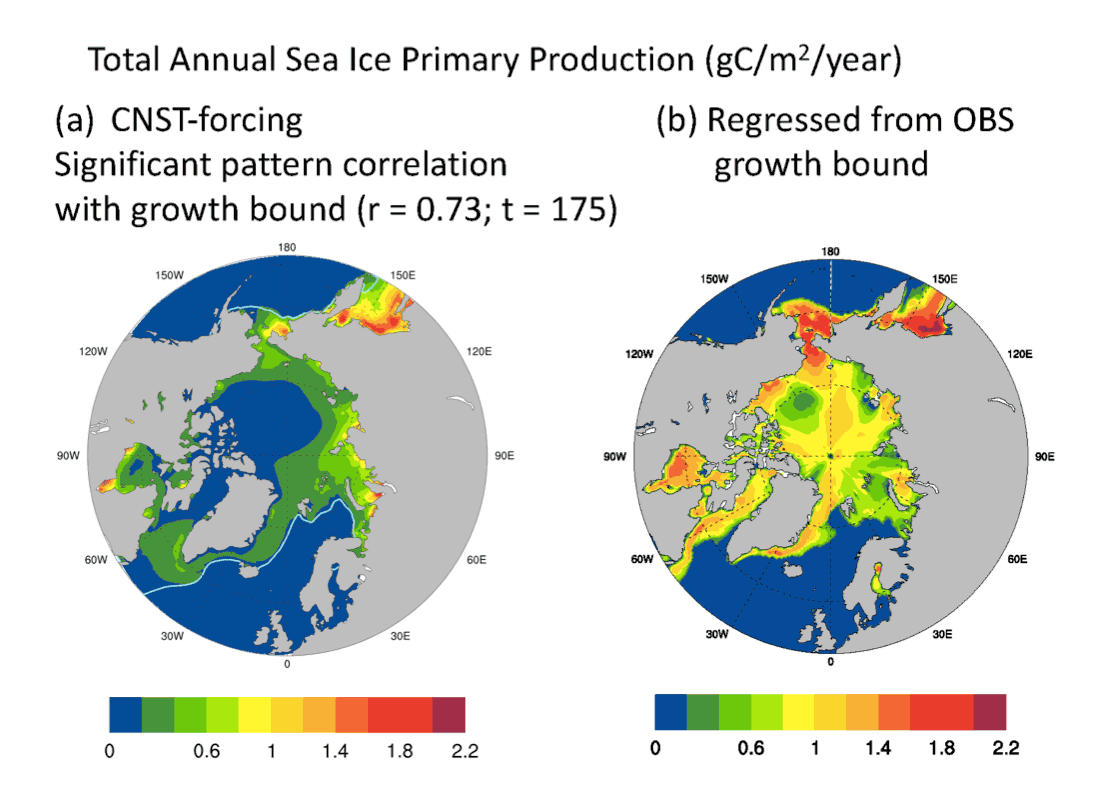Investigating Controls on Sea-Ice Algal Production Using E3SMv1.1-BGC

Figure 1. Mean total annual Arctic primary production (gC/m2/a) in CNST-forcing (a) is significantly correlated with a bound for maximal growth (r = 0.73, t-value = 175). (b) is an estimate of Arctic PP using the regression coefficient from (a) (r = 0.73) and the observations based on maximal growth bound. Total integrated Arctic ice PP from (b) is 60.7 TgC/a. Light blue line in (a) indicates the mean 15% sea ice concentration.
The Science
Sea ice algae are a fundamental source of primary production (PP) for polar zooplankton, particularly during the winter and early spring. In addition, there is growing evidence that sea ice primary production is likely critical for the health and survival of many polar fish, marine mammals, and seabirds. Understanding the changing role of sea ice algal production will provide key insights into the ecological integrity and stability of polar regions. In a recent study, scientists incorporated sea ice algal dynamics in 300 years of pre-industrial (CNST-forcing, which is repeated 1850 conditions for all forcings) and historical simulations of the E3SMv1.1-BGC global model to identify and quantify coupled constraints on sea ice PP (Fig. 1).
The Impact
Simulations of polar integrated sea ice primary production support the lower bound of published estimates for both polar regions with mean Arctic values of 7.5 and 15.5 TgC/a in the Southern Ocean. However, comparisons of the polar climate state with observations, using a maximal bound for ice algal growth rates, suggest that the Arctic lower bound is a significant underestimation driven by biases in ocean surface nitrate and that correction of these biases supports as much as 60.7 TgC/a of net Arctic primary production.
Summary
The E3SMv1.1 model includes a novel, eight-element sea-ice biogeochemical component which is resolved in 3D and uses a vertical transport scheme based on internal brine dynamics. Modeled ice algal chlorophyll-a concentrations are broadly consistent with observations; upper ice communities of the Southern Ocean are underestimated. Simulations of polar integrated sea ice primary production support the lower bound in published estimates for both polar regions, however correction of modeled upper ocean biases suggests that annual Arctic sea ice primary production may be as high as 60.7 TgC/a.
Publication
- Jeffery, N, M Maltrud, E Hunke, S Wang, J Wolfe, A Turner, S Burrows, et al. 2020. “Investigating controls on sea ice algal production using E3SMv1.1-BGC.” Annals of Glaciology 1-22. https://doi.org/10.1017/aog.2020.7.
Funding
- The U.S. Department of Energy Office of Science, Biological and Environmental Research supported this research as part of the Earth System Model Development Program Area through the Energy Exascale Earth System Model (E3SM) project and as part of the Regional & Global Model Analysis Program Area through the Reducing Uncertainty in Biogeochemical Interactions through Synthesis and Computation (RUBISCO) Scientific Focus Area (SFA).
Contact
- Nicole Jeffery, Los Alamos National Laboratory


